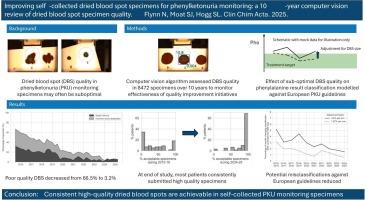改进自行采集的干血斑标本用于苯丙酮尿监测:干血斑标本质量的10年计算机视觉回顾。
IF 2.9
3区 医学
Q2 MEDICAL LABORATORY TECHNOLOGY
引用次数: 0
摘要
背景:苯丙酮尿(PKU)的生化监测采用干血斑(DBS)标本,通常由患者或护理人员采集。DBS质量会影响DBS苯丙氨酸的检测结果,而自行采集的标本质量可能不太理想。然而,目前尚不清楚标本质量如何影响PKU监测结果的临床解释,或者在这种情况下是否可以实现DBS质量的持续改善。方法:我们使用计算机视觉算法客观评估从111名PKU患者收集的10年间8472例 dB标本的DBS质量。标本质量随时间、患者和标本采集频率的变化趋势进行了分析。我们根据欧洲PKU治疗指南模拟了次优DBS大小对苯丙氨酸结果分类的影响。结果:10年间,质量差的DBS比例从66.5 %下降到3.2 %。每位患者每年返回合格标本的中位数比例由2015/16年度的28.6 %提高到100% %。返回标本频率越高的患者DBS质量表现越好,2024-25年度返回≥10份标本的患者接受率为96.3% %,而返回标本的患者接受率为78.3% %。结论:未经培训和教育,自采标本的DBS质量可能很差。然而,PKU监测标本的实质性改进是可以实现的,减少了总测量误差和错误临床解释结果的风险。本文章由计算机程序翻译,如有差异,请以英文原文为准。

Improving self-collected dried blood spot specimens for phenylketonuria monitoring: a 10-year computer vision review of dried blood spot specimen quality
Background
Biochemical monitoring of phenylketonuria (PKU) is performed using dried blood spot (DBS) specimens, usually collected by the patient or carer. DBS quality affects DBS phenylalanine results and self-collected specimen quality may often be sub-optimal. However, it is unclear how often specimen quality affects clinical interpretation of PKU monitoring results, or whether sustained improvements in DBS quality are achievable in this setting.
Methods
We used a computer vision algorithm to objectively assess DBS quality in 8472 DBS specimens collected from 111 PKU patients over a 10-year period. Trends in specimen quality were analysed over time, by patient, and by frequency of specimen collection. We modelled the effect of sub-optimal DBS size on phenylalanine result classification against European PKU treatment guidelines.
Results
The proportion of poor-quality DBS decreased from 66.5 % to 3.2 % over a 10-year period. The median proportion of acceptable specimens returned by each patient each year improved from 28.6 % in 2015/16 to 100 %. Patients returning specimens more frequently showed better DBS quality performance, with acceptability rates of 96.3 % in patients who returned ≥10 specimens in 2024–25, compared to 78.3 % in patients who returned <5 specimens. Improvement in DBS quality reduced potential misclassification against PKU treatment guidelines due to DBS size from 3.1 % to 0.6 %.
Conclusions
Without training and education, DBS quality in self-collected specimens may be very poor. However, substantial improvements are achievable for PKU monitoring specimens, reducing total measurement error and the risk of incorrect clinical interpretation of results.
求助全文
通过发布文献求助,成功后即可免费获取论文全文。
去求助
来源期刊

Clinica Chimica Acta
医学-医学实验技术
CiteScore
10.10
自引率
2.00%
发文量
1268
审稿时长
23 days
期刊介绍:
The Official Journal of the International Federation of Clinical Chemistry and Laboratory Medicine (IFCC)
Clinica Chimica Acta is a high-quality journal which publishes original Research Communications in the field of clinical chemistry and laboratory medicine, defined as the diagnostic application of chemistry, biochemistry, immunochemistry, biochemical aspects of hematology, toxicology, and molecular biology to the study of human disease in body fluids and cells.
The objective of the journal is to publish novel information leading to a better understanding of biological mechanisms of human diseases, their prevention, diagnosis, and patient management. Reports of an applied clinical character are also welcome. Papers concerned with normal metabolic processes or with constituents of normal cells or body fluids, such as reports of experimental or clinical studies in animals, are only considered when they are clearly and directly relevant to human disease. Evaluation of commercial products have a low priority for publication, unless they are novel or represent a technological breakthrough. Studies dealing with effects of drugs and natural products and studies dealing with the redox status in various diseases are not within the journal''s scope. Development and evaluation of novel analytical methodologies where applicable to diagnostic clinical chemistry and laboratory medicine, including point-of-care testing, and topics on laboratory management and informatics will also be considered. Studies focused on emerging diagnostic technologies and (big) data analysis procedures including digitalization, mobile Health, and artificial Intelligence applied to Laboratory Medicine are also of interest.
 求助内容:
求助内容: 应助结果提醒方式:
应助结果提醒方式:


